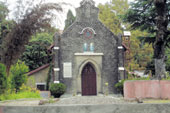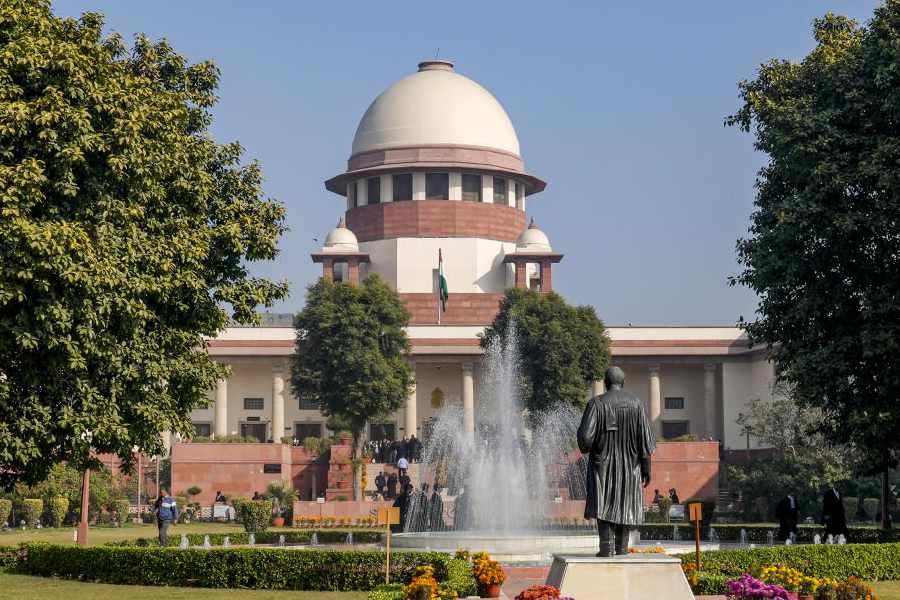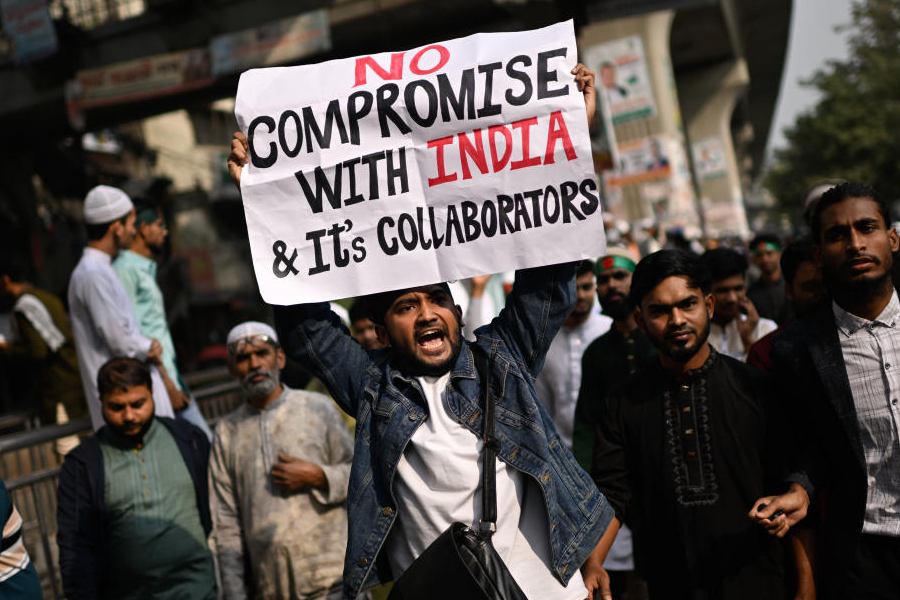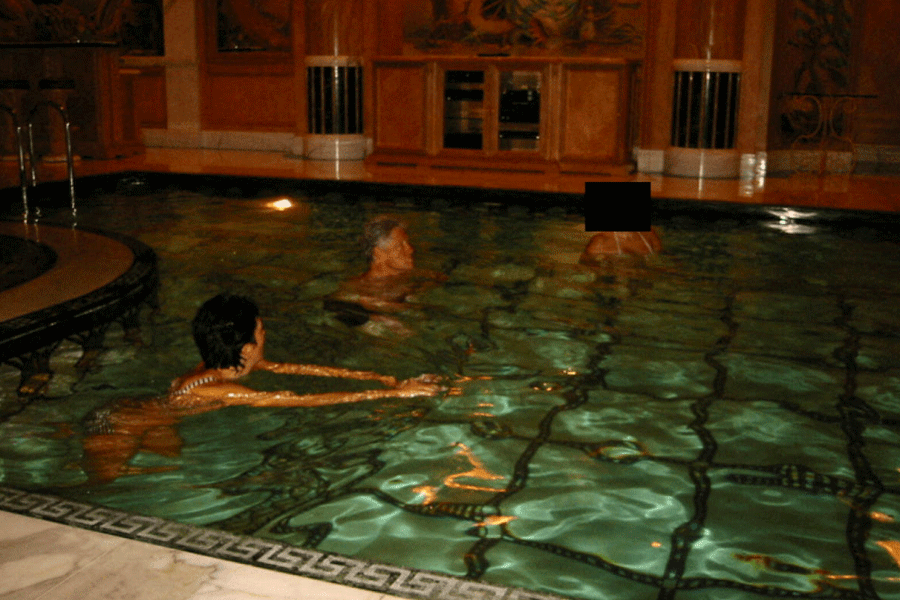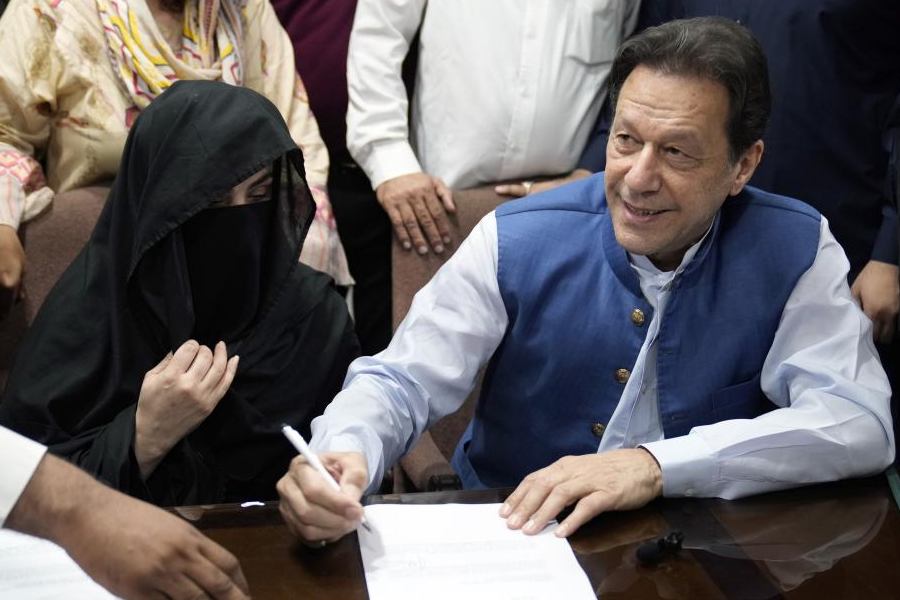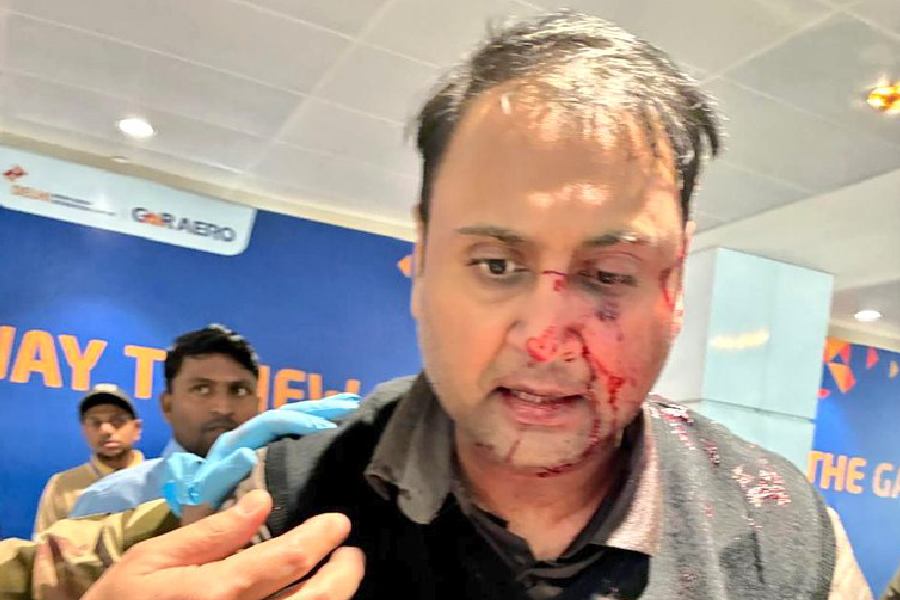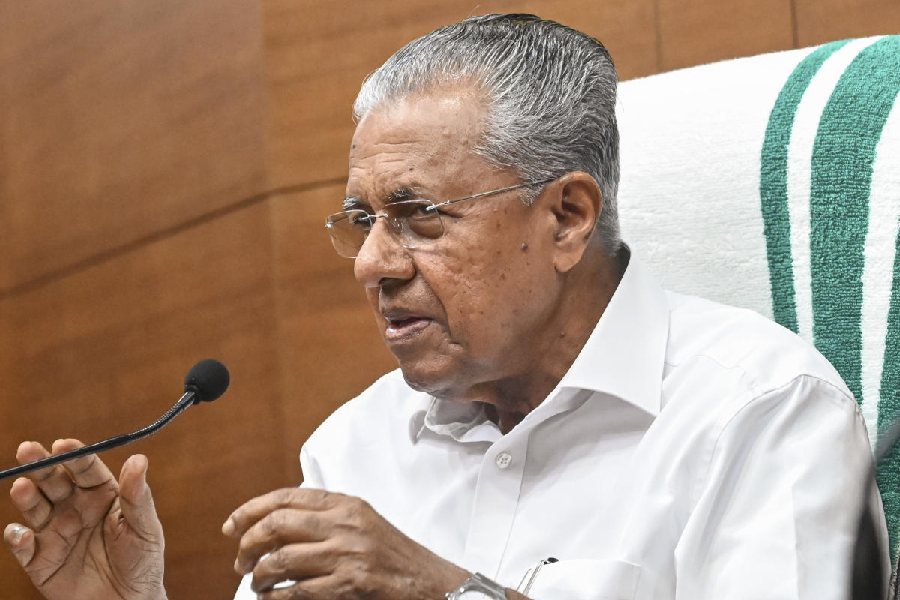 |
 |
 |
 |
| (From top): A church; snow-capped vistas; a view of the area and cottages with wild rose creepers — all part of Lansdowne’s attractions |
I get the first whiff of the hills in Kotdwar ? ironically a little town besieged by diesel fumes and screeching horns. But I can smell the mountains in the air. Lansdowne, after all, is barely 40km away.
It’s a mellow, autumnal day. We ? three car-loads of people ? have set out from Delhi for Lansdowne. We’ve never been there before, though it is the closest hill-station from Delhi, 250km away. A few friends have visited the little cantonment town and have been singing paeans to it ever since.
We leave Kotdwar behind, and start moving up the winding road that is going to lead us to the Uttaranchal Himalayan town. We have left the trees of the plains behind, and are cruising past majestic pines lining the roads. We roll the windows down. The air is cool and crisp and smells of pine needles.
That, to my mind, is the best thing about a trip to the mountains from the plains. There is nothing quite like the first hint of the mountain air and the first gleam of the hills at a distance. My heart starts to sing. Unfortunately for my co-passengers, so do I.
The trip to Lansdowne is long overdue, after all we’ve heard about it. There are lovely little places to stay in ? some put up at the Garhwal Mandal Vikas Nigam hotel, and some at the Garhwal Regimental centre. But I have been making plans to visit the town ever since I read about a hotel called Fairy Dale. It sounds idyllic ? a cottage surrounded by pine trees and flowers. I start a search for a contact number ? a project that yields results a year after I set it rolling. A friend returns from Lansdowne with a scrap of paper and a number scribbled on it. He stayed at the Garhwal Regiment mess, but used to go to Fairy Dale for its parathas every morning.
So I call up, fixing up rooms for 10 people. I am a little nervous, because I am leading a group of professional cribbers. I haven’t seen Lansdowne myself, and have a mere mental picture of Fairy Dale. What if it turns out to be a disaster? I am like a bridegroom on the first day of his honeymoon.
But the journey so far has been great. We have taken a diversion from Meerut to the Bijnore-Kotdwar Road. The road from Delhi to Lansdowne was good ? and the stretch from Meerut to Kotdwar was like Hema Malini’s cheeks ? not now, but when she was 17.
It’s a five-hour journey from Delhi to Lansdowne, some 80km from Pauri, if you are travelling in one car. We are in three cars, and stop every now and then. Still, we are in Lansdowne in a little over six hours.
The first sight of the town ? at a height of 1,706m ? is promising. It’s a quaint little place, dotted with small cottages with wild rose creepers on gates and walls. In Delhi, we had left a blazing sun behind. In Lansdowne, there is a nip in the air, and the sun is a mellow golden. We drive up into the town, till we reach a sign that says Fairy Dale. We go down a narrow strip and spot our hotel. It is indeed a sprawling cottage with wild flowers and pine trees.
We ask for tea and assorted pakoras to wash away the wear and tear of travel. Once suitably invigorated, we step out to see the town. A walk downhill leads us to the market square. The local people are all there. Young boys with dusty knees and girls with bright ribbons are on their way back home from school. Old women heavily laden with bundles of sticks and twigs walk by. There are men on the pavements, contentedly smoking their beedis.
And the nice thing is that there are no tourists. Since it’s a cantonment town and the army has its own stringent rules on construction, there are only a few hotels in Lansdowne. There are a couple of small hotels in the market and the Garhwal Tourism hotel and Fairy Dale.
Lansdowne, its residents tell me, is a curious mix of cultures. There’s been a mingling of Kumaoni and Garhwali traditions since the first battalion of the Garhwal Rifles moved from Almora in Kumaon to Lansdowne in Garhwal, back in 1887 when the town was set up by Lord Lansdowne. Over the years, other communities moved in, adding to Lansdowne’s identity. There were jobs in Lansdowne because of the military, and people from different regions started flocking to the town for employment. Today, there is a sizeable population of Rajasthanis, Kannaujis and Gorkhas there, among other communities.
| How to get there |
| • By road: 250km from Delhi. From Meerut to Bijnore, Najibabad, Kotdwar and then Lansdowne. Places to Stay: |
Fairy Dale, for instance, is run by a genial Marwari gentleman called Ashok Khandelwal. It was his grandfather ? belonging to a family of jewellers from Rajasthan ? who first moved to Landsdowne. So the food at the cottage, much to my delight, is often Marwari. I love gattey ki sabzi ? a curry made out of powdered and steamed chickpea. And the homemade green chilli pickle stuffed with mustard seeds and other kinds of masalas is just out of this world.
I spend my days in Lansdowne recharging my batteries. I doze in the sun, feed and rehydrate myself through the day, read my books and go for reluctant walks. There are some people in the group who alarm me. They are up at five in the morning and walk some 15km before returning to the cottage for breakfast.
One of the popular neighbouring areas for a trek is the Tarkeshwar Mahadev temple, 35km from Lansdowne. The place sounds promising, for it is ringed by thick oak and pine trees. We plan a picnic ? carrying with us hampers of stuffed parathas. But we demolish the parathas ? filled with onions, potatoes, cauliflower and cottage cheese ? for breakfast, and defer the picnic.
Some of my heartier friends walk up to Jehri Khal, a touristy spot a few kilometres away. Another health-freak walks down to a cemetery, several kilometres downhill, and then walks happily back to the cottage. I limit my perambulations to Tiffin Top ? or Tip and Top, as they now call it ? 3km from the town and at a height of nearly 2,000m. You can stand there for hours, looking at the magnificent vista of the Himalayan peaks right in front of you.
Lansdowne is proud of its religious heritage as well. There are shrines for different religions, all peacefully co-existing. Apart from the Shiv temple on the outskirts of Lansdowne, there are two beautiful churches ? St Mary’s and St John’s ? right in the town. There is even an old mosque where both the Shia and the Sunni communities pray together.
There is something in Lansdowne for all of us. It is a peaceful place with a salubrious air for those who just plan to chill. There are long walks for those who wish to exercise their limbs. A friend who is fond of plants and flowers spends her time looking at the grand pine and oak trees and the wild flowers that grow in abundance all over. And I spend my time thinking about food ? while discussing the day’s menu with Mr Khandelwal.
This is what a holiday is all about. I am glad we found Lansdowne. I don’t know how Lansdowne found us ? but we will be back.
Photographs by Navneeta Barooah and Rahul Verma
Flying high
 |
| Lufthansa’s Werner Heesen: the sky’s the limit |
Lufthansa’s Werner Heesen is an old India hand. He has been flying back and forth between Germany and India since 1985 and during this time Lufthansa has cemented its position as the top European carrier to India in terms of the number of flights each week. And business has climbed steeply in the last two years. Says Heesen, “India is a crucial, strategic market for Lufthansa.”
And this is why: Lufthansa has soared ahead with a mammoth 70 per cent growth in the last two years going from 23 weekly flights arriving and departing from India to 32. And as part of its capacity expansion plans, come November, and it will add another six flights, taking the total number of connections between India and Germany to 38 (out of an Asia-Pacific total of 149).
So what’s Lufthansa’s current USP? Well, it flies to five Indian cities (Delhi, Mumbai, Chennai, Bangalore and Hyderabad) and passengers can fly to either Frankfurt or Munich (it’s the only European airline that offers flights to two bases). And from there, travellers can connect to the 18 US cities or 85 European destinations on the airline’s network. “The US and Europe are the most frequently wanted destinations by Indians,” says Heesen.
Certainly, Lufthansa has been turning in a steady performance each year in India. The airline ended 2004 with double-digit increases in its revenue and capacity. Passenger numbers carried have gone up by an average of 21 per cent since 2001. Says Heesen, “The Indian market as it is stable, and the mid-term and long-term opportunities are looking positive.”
Way back in 1959, Lufthansa was an early bird in India. The market was very different from today’s highly competitive scene where an increasing number of domestic and international airlines are cris-crossing Indian skies, adding frequencies and ensuring that the travel market is increasing by 10 per cent annually.
Lufthansa commenced scheduled services to India, touching down in Calcutta in November 1959. It landed in Calcutta after flying 30 hours from Frankfurt via Cairo, Kuwait and Karachi. The flight was discontinued in 1963 and the city is yet to be put back on its schedules. Heesen explains, “In the past, the catchment area of Calcutta did not provide passengers to justify service. However, now we have seen high-profile industries moving to Calcutta making way for modern infrastructure. We are making an assessment of the opportunities in Calcutta.”
After calling off Calcutta, in 1963 Lufthansa landed in Delhi with a once-weekly flight to Frankfurt. The route it took was Tokyo-Hong Kong-Bangkok-New Delhi-Karachi-Kuwait-Cairo-Rome-Frankfurt. In 1971 Mumbai was added to its network. Then the airline hit a trough.
It was only in 1994 that Chennai was added to its fold as Lufthansa’s third destination in India, followed by Bangalore in 2001. In February this year, Lufthansa linked Hyderabad and Frankfurt. This year, the airline also opened India to yet another gateway in Europe, connecting Delhi with Munich. “Passengers from Delhi now have the option of two different times and two hubs,” says Heesen.
Currently, 60 per cent of the airline’s travellers (on its Indian routes) are Indians, so they are by far the most important target group. “Thus, the product must suit the needs of the Indian corporate and leisure traveller,” he says.
If you’ve always thought that Lufthansa’s service was cool and antiseptic, read on. Its vast network is only one of its major areas of emphasis. Indian hospitality — warmed up by a battery of some 160 Indian Hindi and Tamil speaking flight attendants — and plenty of Indian publications on board are meant to make Indians feel at home. The airline is also making a big effort to feed its passengers well and recently roped in Taj Group’s celebrity chef, Hemant Oberoi, to unleash his creative juices and plan in-flight menus.
Heesen has been around long enough to see a drastically changed profile of the Indian traveller. In the past, going overseas was the privilege of businessmen and a small clutch of leisure travellers, but today millions can afford to fly abroad. Corporate travel is on an upward swing, and people want to discover destinations like Europe and America. “What’s more, the age pyramid has changed to include younger people on the move. Young Indians are self-confident, quality and price conscious, being well-informed and technology savvy,” says Heesen.
But what about the Indian aviation industry and its antiquated airports? Heesen shoots back with, “The aviation industry is not fully liberalised yet, as we don’t have a completely open sky policy, but what we have is a gradual change towards liberalisation.”
Besides, the on-ground facilities are a trouble spot. The airports in Delhi, Mumbai and Bangalore have limited capacity in terms of slots (parking areas) and aerobridges. And with the number of flights increasing, that’s going to be a serious problem. “The government has taken steps towards modernising the infrastructure but it must be understood that the time-span from the planning stage to the implementation takes a minimum of three years or more. We may thus face a bottleneck situation in the next five years.”
Passengers may be disappointed to hear that fares won’t be dropping too much in the near future — even though more flights are cruising into the runway. That’s because fuel costs are climbing steeply. Says Heesen, “Fuel costs have escalated and airlines all over the world have to respond to this.” Purchase and maintenance of aircraft, navigation and landing charges have all only gone up. While travellers can expect special promotions which are temporary in nature, a long-term drop in fares seems unlikely unless the global scenario changes dramatically.
Nevertheless, fares are going down from their earlier high levels, so it’s still a win-win situation for Indian travellers as competing airlines try their best to woo them with a mix of better prices, quality and innovation.
Photograph by Rupinder Sharma
My favourite holiday
 |
Agnimitra Paul,
fashion designer
Just a few months ago, I visited Switzerland with a group of friends. We stayed in the small yet quaint town of Basel — just 20 km away from Germany and France on either side. Of course, Switzerland lived up to every expectation with its stunning vistas, gorgeous weather and so much more. Yes, we did hit all the usual tourist hotspots like Engelberg, Mount Titlis and Jhunfraujoch. But the best part about our trip had to be that all of us stayed together in a good friend’s house, and essentially had a whale of a time doing everything on our own including cooking.
The River Rhine flows through Basel and in the evenings, we’d head towards the river bank for fishing. On weekends, a stage is erected on the river and an entertaining variety performance is held. All the townspeople gather for the programme which continues late into the night. With its carnival spirit, this is loads of fun!
Although we spent just four days in Basel after which I carried on to Paris and Newcastle, my stay in Switzerland will remain with me for some time yet!
Route map
It’s not just five-star hotel chains that intend to give you the best deals this winter. If your budget is more modest, you could always look for getaways in the growing middle range hotel market. ITC’s Fortune Hotels is wooing travellers with tempting offers. All the tariffs, based on the type of room you opt for and the meals thrown in, are on a per-night, double-occupancy basis. The chain’s Port Blair property, Fortune Resort Bay Island, offers a package for two adults at Rs 4,999 and includes two half-day sightseeing trips as well. High in the Nilgiris, Fortune Hotel Sullivan Court in Ootacamund offers a package of Rs 4,699. At Fortune Kences Hotel at Tirupati, you get to pay Rs 2,399, Rs 1,999 and Rs. 1,499. Close to the famed Madurai temples, Fortune Pandiyan Hotel in Madurai, is also offering interesting packages. On offer are rooms that will cost Rs 2,399, Rs 2,599 and Rs 2,099.
In the north, Jodhpur’s Fortune Ummed has value-for-money packages. Travellers can take their pick of rooms at Rs 4,999 or Rs 3,999. In Darjeeling, the chain’s Fortune Resort Central and Fortune Resort Mountain Lodges are attracting their share of guests. The package at the Fortune Club rooms at the resorts is priced at Rs 4,499 and Rs. 2,399. This includes a half-day sightseeing trip for those opting for a 2-night stay and two free sightseeing trips for a 3-night stay.

